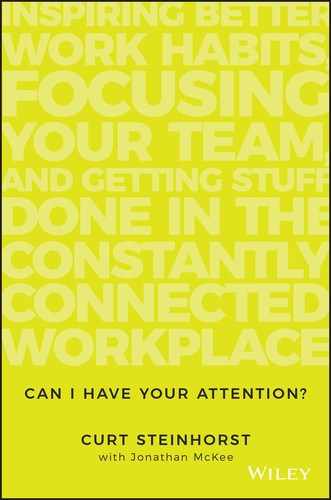Chapter 1
The Curse of the Overwhelmed
Twenty-two.
That's how many e-mails have arrived in the past 15 minutes as I've tried to write this opening. And because I indulged the temptation to check, I'll work longer and get less done today. I probably won't even realize it.
Been here before? Know someone who has?
You're not alone. Ask your people how work is going and you'll hear:
Sure, people feel overworked, but that's not the problem. We confuse busyness and activity with actual work, so what feels like overworked is actually overwhelmed. What's the difference? To find out, let's go back to my inbox.
Of those 22 e-mails, three were from employees, one was from a client, one was from a prospect, and five were newsletters or promotions.
The other 12? They were from people who were supposed to be working. But weren't.
These are friends who work in fields like consulting, accounting, medicine, journalism, and software sales, sending messages such as, “Where did you buy that Ninja blender?” at 10:30 AM on a Tuesday. Twelve out of 22 isn't bad—one study says 86 percent of the e-mails we get aren't critical for work.1
Hey, I'm Doing My Job
Most people don't think distractions affect their productivity. They are distracted, they say, but they still get to what needs to be done. As someone who has studied distraction for years, I can tell you that very few people are honest about its cost in their lives, and almost none have realistic strategies to overcome it. They think they're working harder and more efficiently than ever. But they've never actually worked less.
Since 2007 (the same year, notably, that the iPhone was released), the decline in employee productivity has been staggering. One efficiency expert says we can lose more than six hours a day to interruptions.2 Another estimates that these interruptions waste 28 billion hours a year, costing the U.S. economy nearly $1 trillion.3 A different study about multitasking—a mantra for many employers—found that it costs the economy $450 billion annually.4
While productivity has plummeted, connectivity—the extent to which we have access to one another—hasn't.
And with all that constant connection, the borders between work and life are crumbling.
In one survey, 87 percent of employees admitted to reading political social media posts at work.5 Other research shows that 60 percent of all online purchases occur between 9 AM and 5 PM and that 70 percent of U.S. porn viewing also happens during working hours6 (“working” from home?). And if none of that convinces you, perhaps this will: Facebook's busiest hours are 1 to 3 PM—right in the middle of the workday.
So maybe it's not surprising when the latest Gallup poll finds that the majority of employees worldwide aren't engaged in their work.7
And yet all these studies might only scratch the surface, relying as they do on the perceptions of people who want to think they're working. How much time do you actually spend on uninterrupted work? How much time do your people?
Yet it's hard to imagine returning to a time when employees like Harry were less accessible and lacked powerful tools at their fingertips 24/7. In truth, we love being able to reach the Harrys in our lives anytime, anywhere. You can call or e-mail him. You can chat via IM because he's usually active. You can text, tweet, or even tap him on the shoulder, since he's probably nearby. No matter your method, he'll respond right away—which is why so many of his colleagues consider him a saint.
But whether those who depend on him know it or not, Harry is far from sainthood when it comes to productivity. Harry commits sins of omission. He fails to accomplish even half of what he's capable of. Although he may get high marks, his actual value has never been lower.
It's easy to blame the employees. But I've got some hard news: The problem is with you.
